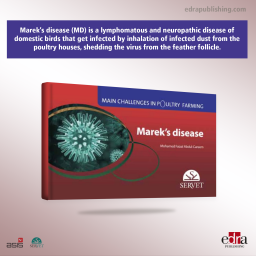





Atlas entirely dedicated to infectious bursal disease based on a practical and graphic approach of the topic. This handbook has been carried out by highly experienced authors closely involved with this disease in Africa, where its prevalence and incidence are significant. This updated work has been carefully developed including the most essential contents, so that it depicts a valuable tool to cope and control this virus as far as possible. Includes many helpful tips and visual graphic resources provided by the authors to enrich and turn this atlas into a reference in its field. Furthermore, diagnosis and vaccination have been thoroughly explained, highlighting vaccination programmes and types of vaccines. The atlas format helps to make the contents understandable for readers.
Atlas entirely dedicated to infectious bursal disease based on a practical and graphic approach of the topic. This handbook has been carried out by highly experienced authors closely involved with this disease in Africa, where its prevalence and incidence are significant. This updated work has been carefully developed including the most essential contents, so that it depicts a valuable tool to cope and control this virus as far as possible. Includes many helpful tips and visual graphic resources provided by the authors to enrich and turn this atlas into a reference in its field. Furthermore, diagnosis and vaccination have been thoroughly explained, highlighting vaccination programmes and types of vaccines. The atlas format helps to make the contents understandable and affordable for the readers.
Authors:
Mohamed Faizal Abdul-Careem
BVSc, MVM, PhD, Diplomate ACPV, Diplomate ACVM (Virology).
Dr. Mohamed Faizal Abdul-Careem is Assistant Professor (virology) at the University of Calgary (Canada) since 2010. He has obtained his basic veterinary degree (BVSc) from the University of Peradeniya (Sri Lanka) and a Master of Veterinary Medicine degree (MVM) from the University of Glasgow Veterinary School (UK) in 1995. He completed his PhD degree from the University of Guelph (Canada) in 2008. His doctoral thesis entitled ‘Characterization of Host Responses Following Marek’s Disease Virus Infection or Vaccination Against Marek’s Disease’. Following his PhD degree, he was awarded a prestigious Canadian Institutes of Health Research Fellowship to conduct post-doctoral research on innate immune responses generated against mucosal viral infections at the Center for Gene Therapeutics of the McMaster University (Canada). He is diplomate of American College of Poultry Veterinarians (ACPV) and American College of Veterinary Microbiologists (ACVM). He has expertise and strong interests in the area of avian viral immunology. He has around 31 manuscripts published in peer-reviewed journals and 90 % of these manuscripts are on avian viral immunology. His research programme at the University of Calgary is supported by grants from Canadian federal, provincial and poultry industry sources such as Natural Sciences and Engineering Research Council of Canada, Alberta Livestock and Meat Agency (ALMA), and Canadian Poultry Research Council. He has established stateof-the-art research facility for his experimental animal and laboratory work at the University of Calgary.
Table of Contents:
1. Aetiology
Overview
IBD virus (IBDV)
Classification
Viral protein structure and function
IBDV particle
Genome
Gene expression
Replication
2. Importance
History
Current status in the world
Economic significance
Poultry production and its contributions
Effects on poultry
Impact on food security
How IBDV causes disease and death
3. Epidemiology
Distribution and persistence
Geographical distribution
Serological survey
IBD status
New epidemiological situation
Morbidity and mortality
Characteristics in the environment
4. Pathology
Type of birds at risk
Transmission
Incubation period
Pathogenesis
Potential risk of spread through trade
5. Clinical signs
Factors influencing disease severity
Clinical signs associated with acute
disease
Classical form
Immunosuppressive form
Acute form
What next after subclinical infection
Relationship between clinical signs and
diagnosis
6. Diagnosis and treatment
Clinical and differential diagnosis
Histological diagnosis
Post-mortem examination
Serological diagnosis
Molecular identification and
characterization
Sampling
7. Prevention and control
Disinfection
Vaccination
Vaccination programmes
Routes of vaccine administration
Categories of IBD vaccines
Advices for vaccinating chickens
8. Actions to take
Measures taken to reduce morbidity and
mortality during an outbreak
Recommended actions after an
outbreak
9. References
Data sheet
Specific References